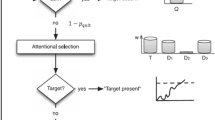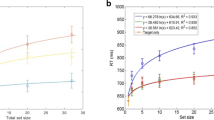Abstract
The model presented here is an attempt to explain the results from a number of different studies in visual attention, including parallel feature searches and serial conjunction searches, variations in search slope with variations in feature contrast and individual subject differences, attentional gradients triggered by cuing, feature-driven spatial selection, split attention, inhibition of distractor locations, and flanking inhibition. The model is implemented in a neural network consisting of a hierarchy of spatial maps. Attentional gates control the flow of information from each level of the hierarchy to the next. The gates are jointly controlled by a Bottom-Up System favoring locations with unique features and a Top-Down System favoring locations with features designated as target features. Because the gating of each location depends on the features present there, the model is called FeatureGate.
Similar content being viewed by others
Author information
Authors and Affiliations
Additional information
Received: 4 July 1997 / Accepted: 23 July 1998
Rights and permissions
About this article
Cite this article
Cave, K. The FeatureGate model of visual selection. Psychological Research Psychologische Forschung 62, 182–194 (1999). https://doi.org/10.1007/s004260050050
Issue Date:
DOI: https://doi.org/10.1007/s004260050050




